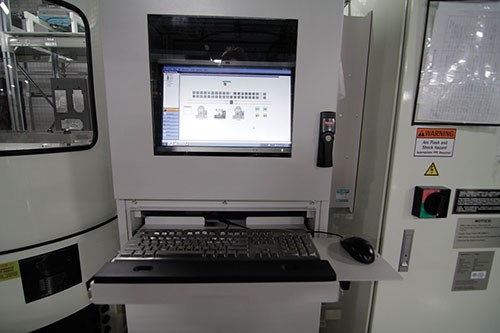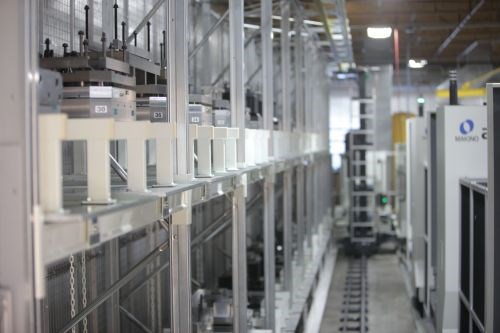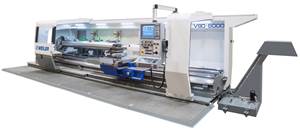Shop-Wide Automation Approach Enables 24/7 Machining
Using a flexible manufacturing system (FMS) and a 24/7 hour machining approach has enabled Micro-Mechanics to make production changes on the fly and virtually eliminate downtime
To machine perfect parts on time, every time, Micro-Mechanics needed to rely less on operator skill and more on improving its machining processes. The company invested in a flexible manufacturing system and implemented a 24/7 machining strategy that would enable on-the-fly adjustments to the production schedule with virtually no downtime.
Micro-Mechanics started its business in a small workshop in Singapore in 1983. Today, the publicly traded company’s manufacturing facilities are located in the Philippines, Malaysia, China, Thailand and the United States. Its Morgan Hill, California, facility serves as a Tier 1 supplier to the semiconductor, medical and high-tech instrumentation industries, in which high-velocity new product introduction is paramount to meeting customer demands.
The company’s 24/7 machining strategy was designed specifically to meet challenges associated with the company’s high-mix, low-volume production requirements. While 24/7 implies 168 hours of continuous production per week, Micro-Mechanics defines it as achieving at least 95 percent spindle utilization, or 160 hours of weekly production. The remaining eight hours are dedicated to predictive and preventive maintenance. The seven core elements of this strategy reach across multiple departments and include: a repeatable machining processes; interchangeability and flexibility; offline fixture and tool setting; 7S housekeeping; defined tools, settings and operating parameters; programming standards; and dedicated engineering and production resources.
To bring this strategy to fruition, Micro-Mechanics collaborated with Joe Clancy at machine tool distributor Clancy Machine Tool to invest in a flexible manufacturing system (FMS). The FMS consists of three Makino a61nx horizontal machining centers, an MMC2 track pallet system and the Makino automated system (MAS-A5) cell control software. While the FMS provided a flexible and expandable platform for 24/7 machining, making the most of the new system depended on changing the company’s approach to production.
One example is eliminating activities that interrupted production and affected machine utilization. Two factors that couldn’t be eliminated, fixture and tool setting, are now handled by an offline tooling department responsible for controlling tool characteristics to ensure consistent, repeatable production. To accomplish this, the company uses RFID chips, runout monitoring, tool balancing, Cpk calculations and standardized operating and tool setup parameters.
“There’s only one factor of the machining process that will always remain constant, and that’s the inevitability of tool wear,” says Bill Green, manufacturing engineer for Micro-Mechanics’ tooling group. “Between our toolholders and presetter, we’ve been able to effectively control tooling runout within 0.0005 inch before the tool reaches the cell. Additionally, our balancing capabilities, complemented by the rigidity of the a61nx machines, have provided higher accuracy, better surface finish and as much as three times longer tool life.”
Key to the success of Micro-Mechanics’ offline tool management is the MAS-A5 cell controller, which features a direct link from the line to the tooling department for instantaneous transfer and storage of tool data. Mr. Green says the controller acts as the “central nervous system” of the company’s tool data management by connecting and coordinating information between the tooling department, operators and machines. Among other benefits, this enables tooling to be replaced ahead of time, before production has been impacted.
Also, easy access to tool drawings facilitates on-the-spot troubleshooting for faster error resolution.
To maintain consistent performance across all 24/7 machining groups, the tooling department has a set list of tools that can be applied to all programmed machining processes. Detailed information on each of these tools is included in a tooling matrix with tool types, pod numbers and operating parameters. All the machines in the line are equipped with identical tool magazines to ensure that any part can be produced on any machine at any time. Identical spare tools are also created and loaded in the magazine to ensure uninterrupted machining once the pre-established wear limits on the tool have been met.
The fixture department also applies similar principles for standardization in the design and development of its tombstones and fixtures. For example, regardless of part applications, all fixtures are designed and machined from pre-machined, cast aluminum and are anodized to protect accuracy. Additionally, all hardware, including clamps, dowels and helicoils are standardized and purchased from approved suppliers.
To ensure high levels of repeatability, the fixture department designs its custom tombstones in-house. Each tombstone is built within a true position of less than 0.001 inch with one-time locating to pallets within 0.0005 inch. According to Mr. Fisher, fixtures can be transferred between like tombstones without any offset adjustments and still hold positioning tolerances within 0.005 inch across all coordinate axes. Of course, he says, this repeatability is dependent on the flatness and quality of Makino’s basic pallet on the a61nx.
With predictable, flexible and interchangeable tooling and fixturing methods in place, Micro-Mechanics focused its attention on standardizing its programming and design practices. “Developing programming standards made everything come around full-circle and closed the loop for our 24/7 engineering,” says Mike Maguire, Micro-Mechanics’ manufacturing engineering section manager. “Since the tooling group had already established operating parameters, we just had to normalize our coding procedures and cutter paths to ensure that the same tools were used in the same way on similar features to produce repeatable results. As such, our first article inspection is no longer an evaluation of parts, but processes,” he says.
Micro-Mechanics also unified all of its programming and design practices into identical software platforms to ensure that all designers and engineers see the same things when a file is opened. To avoid potential bugs, the company never applies new software releases until after the first update is distributed. “The biggest benefit to our programming and design standards is that there is no more second-guessing. As long as we’ve followed the guidelines put into place, we know a program will work. That’s the difference between a skill and the science of machining,” Mr. Maguire says.
To complete its 24/7 machining line, Micro-Mechanics needed to address the fundamentals of preventive maintenance and 7S housekeeping, which factors safety and sustainability into the well-known 5S methodology. Chris Borch, CEO of Micro-Mechanics, says many manufacturers overlook what they consider to be minor supplemental activities, such as cleaning chips from fixtures and organizing setup tools. However, disregarding these fundamentals has a negative effect on a machining process in the end, he says. The initial costs of equipment pale in comparison to the savings in ongoing costs Micro-Mechanics is able to achieve in terms of long-term productivity and accuracy of its 24/7 machining process. “Our mind-set is that we’d rather clean, replenish and replace and not repair. This is why we dedicate eight hours each week to basic cleaning and preventive maintenance procedures,” Mr. Borch says. “While this may reduce our number of productive hours in the short term, decreasing the likelihood of significant repairs will ultimately gain us more long-term productivity and ensure the accuracy and repeatability of our 24/7 machining process.”
The company received its first prod-uction order for the 24/7 machining line in June 2012. While Micro-Mechanics has not yet reached 168 hours of non-stop production, the pursuit of this obj-ective has already improved competitiveness. It is evaluating future improvements, including further optimization of fixturing methods through RFID. It has also started early planning to replicate its current capabilities with the addition of a second Makino cell. Once installed, the cell is expected to help Micro-Mechanics create separate and dedicated resources for engineering and production—the final key fundamental for 24/7 machining.
Related Content
Lean Approach to Automated Machine Tending Delivers Quicker Paths to Success
Almost any shop can automate at least some of its production, even in low-volume, high-mix applications. The key to getting started is finding the simplest solutions that fit your requirements. It helps to work with an automation partner that understands your needs.
Read MoreWeiler to Debut New Automation Features For Its Lathes
Weiler’s V 110 four-way precision lathe introduces features new to the U.S.
Read More4 Steps to a Cobot Culture: How Thyssenkrupp Bilstein Has Answered Staffing Shortages With Economical Automation
Safe, economical automation using collaborative robots can transform a manufacturing facility and overcome staffing shortfalls, but it takes additional investment and a systemized approach to automation in order to realize this change.
Read MoreChoosing a Five-Axis Machine Tool With Automation in Mind
While much focus is placed on the machinery that moves parts, the features most important for automating five-axis machining are arguably found in the machine tool itself.
Read MoreRead Next
3 Mistakes That Cause CNC Programs to Fail
Despite enhancements to manufacturing technology, there are still issues today that can cause programs to fail. These failures can cause lost time, scrapped parts, damaged machines and even injured operators.
Read MoreThe Cut Scene: The Finer Details of Large-Format Machining
Small details and features can have an outsized impact on large parts, such as Barbco’s collapsible utility drill head.
Read More












.png;maxWidth=300;quality=90)










.png;maxWidth=300;quality=90)









